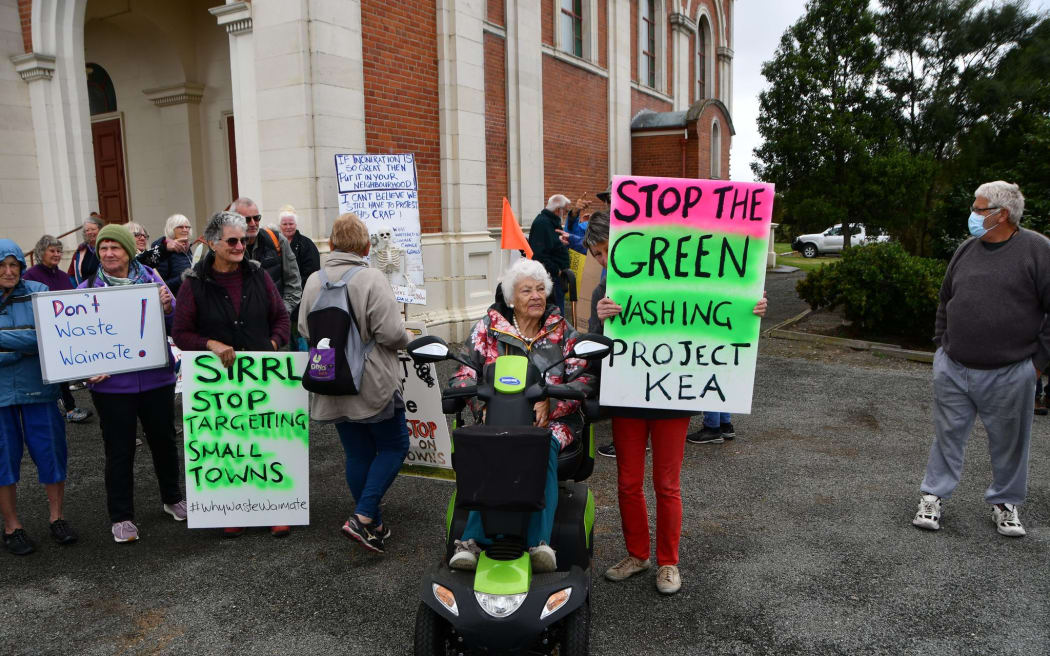A decision on what could be New Zealand's first waste-to-energy plant that uses rubbish to generate electricity is now in government hands, after its national significance was recognised.

Locals gather in Waimate to protest the proposed waste-to-energy plant. Photo: Supplied / Barry Marshall
If we could get rid of all the rubbish that currently goes to landfill – in a process that would generate electricity as a by-product – shouldn't we be doing that?
Plans for a waste-to-energy plant in a small South Island town have reignited this debate.
South Island Resource Recovery Limited (SIRRL), a company backed by Chinese interests, wants to build a waste-to-energy plant it calls Project Kea in tiny Waimate.
If built, it would burn 365,000 tonnes of rubbish a year. That's about 20 percent of the South Island's total annual waste.
In turn, it would produce enough energy to power 30,000 households.
SIRRL's application for consent was turned down twice by the Waimate District and Canterbury Regional councils for lacking "fundamental information", but after an independent commissioner stepped in the application was accepted – and has now been taken over by the Environmental Protection Authority, with minister David Parker saying the project is of national significance.
If approved, the plant would be the first of its kind in New Zealand – although there are plenty of them overseas, mostly in Europe.
"We don't have any regulations set up for this, and it requires a lot of very specific expertise to assess what are the risks and harms," says George Driver, the South Island correspondent for North & South magazine, who's been researching and writing about the issue.
He outlines the history of the proposal to The Detail today, including the reason why locals are dead against it.
Project Kea is essentially a giant incinerator that would burn municipal waste, producing steam in the process that powers turbines to produce electricity. It also produces toxic leftovers, which in this case would be processed into effectively a glassy material that won't leach – it could be used in construction, as a filler in concrete, for example.
Professor Jim Jones, a professor of chemical and bio-process engineering at Massey University, has been looking at SIRRL's application documents – the ones not written in Mandarin – to get a sense of what's involved.
"There is a general question out there that the public are asking – rightly – around these types of systems," he says.
"Europe started doing waste-to-energy a long time ago, but they become a large plant that needs feeding. So the operators of the plant are then starting to look around for, what is it that we can put into the plant to keep feeding it? People who are more interested in ensuring that we're recycling things rather than just combusting them – the issue becomes 'it's a place it can go ... it can just be burnt."
The plan would also seem to be a departure from the government's stated aims on waste disposal: to reduce and recycle rubbish. It wants to lessen the attractiveness of taking waste straight to landfill by charging progressively higher tip levies, encourage recycling, ultimately ban some products, and make manufacturers responsible for the whole-of-life duration of their products.
The very material it is trying to stop entering rubbish dumps is the fuel for such plants. That fuel is required 24 hours a day, for decades.
"One of the biggest criticisms is the 'feed the beast' argument," says Driver. "That once you build them you have to keep feeding them with waste, for 20 or 30 years. Where they've been very popular, in Scandinavia, some countries have begun importing rubbish to keep these things burning rubbish because they've built so many of them."
Denmark, which has the most plants, is decommissioning seven of them because they're doing nothing to bring CO2 emissions down.
As for any harmful emissions from the plant, Professor Jones says it's hard to predict what's coming out when you don't always know what is going in.
"If you've got hazardous materials going in you need extremely good scrubbing systems to make sure they don't come out the other end."
He says while on paper the technology looks good, there appears to be a lack of trust for such a plant in New Zealand at the moment – both in terms of what the company is promising, and the ability of authorities to monitor it.
For more on how the rubbish-to-electricity process works, listen to the full podcast.
Check out how to listen to and follow The Detail here.
You can also stay up-to-date by liking us on Facebook or following us on Twitter.

Photo:


